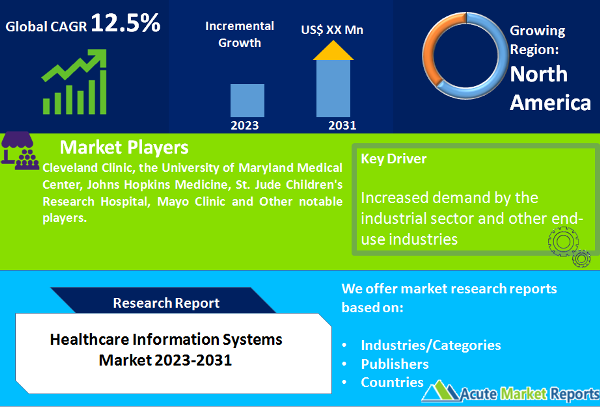
The global market for healthcare information systems is projected to develop at a compound annual growth rate (CAGR) of 12.5% during the forecast period of 2025 and 2033. Increasing healthcare expenditures and improvements in the industry's IT infrastructure are two of the key factors driving market growth. The adoption rate of remote patient monitoring is also substantially influenced by its high demand. According to a survey published in the journal The Lancet in 2016, global health expenditures are projected to reach USD 18.3 trillion by 2040.

Increasing Technology Innovation to Drive Market Expansion
The establishment of patient registries and patient portals, patient-centered care management, population health management, and point-of-care solutions assist practitioners in reducing healthcare costs and improving outcomes. Innovations in healthcare IT infrastructure, such as the usage of IoT, big data, and AI, are one of the most important factors driving market expansion. There are more healthcare IT solutions for cybersecurity and AI applications as a result of the development of newer technologies by businesses. Interoperability of data, AI, and machine learning (ML) are among the most promising.
Increasing Prevalence of Chronic Diseases
The rise in the prevalence of chronic diseases such as diabetes, cancer, and congestive heart failure is a major factor in the adoption of remote patient monitoring services, which is anticipated to increase the industry's demand for IT solutions. According to estimates from the International Diabetes Federation (IDF), the number of persons with diabetes is projected to increase to 643 million by 2033 and 785 million by 2045. The American Cancer Society anticipated that approximately 1,9 million new cancer cases would be diagnosed in the United States in 2021.
mHealth Programs and Remote Patient Monitoring to Drive Healthcare IT Solutions
Several businesses and healthcare organizations are developing mHealth programs for remote patient monitoring, resulting in a rise in the usage of IT solutions for remote patient monitoring services. In 2019, the Marshfield Clinic Health System in Wisconsin will employ mHealth devices for remote monitoring of congestive heart failure patients. eHealth initiatives include the development of current IT infrastructure and the promotion of patient participation and patient-physician collaboration technologies. Globally, the number of projects for the deployment of eHealth is increasing.
Government Initiatives to Significantly Boost the Market Growth
Europe is among the regions that invest extensively in eHealth infrastructure development. As a result of these measures, the EU is boosting its use of eHealth to improve health service delivery and public health. According to a 2016 WHO report that provides an overview of the EU's eHealth status, 30 of the 53 member states have a national eHealth policy. Moreover, developing nations are adopting eHealth through a variety of initiatives. India and the Netherlands joined in the field of eHealth in October 2020 to give digital health facilities and security to Indians, as well as to assist the Netherlands in speeding up the digital transformation of health.
Increasing Applications Segments to Expand the Market Opportunities
Growing smartphone applications, such as telemedicine, remote illness management, Health Management Information Systems (HMIS), and others, are broadening the reach of information technology, particularly in healthcare. It is projected that technological advances in smartphone technology to improve disease diagnosis would fuel the expansion of IT in this industry. According to 2017 data, researchers at the University of Illinois have developed a camera to enhance the diagnostic capabilities of cell phones.
Revenue Cycle Management (RCM) Dominated the Market for Applications
In 2024, the revenue cycle management (RCM) sector held the biggest market share at 65%. This is a result of the requirement to reduce medical billing errors, decrease healthcare reimbursements, shift the trend toward the creation of synchronized management systems, and increase the need to optimize workflow in healthcare facilities. According to a study by 2020, over 67% of providers are utilizing AI for RCM, and almost 100% of the surveyed executives anticipate implementing AI for RCM within the next three years. This is anticipated to increase RCM's growth rate during the projection period.
The increasing use of hospital information systems to increase operational efficiency, growing awareness of technologically advanced services, and the resulting need to reduce healthcare costs are among the key drivers driving the hospital information system market. In healthcare, the need for analytical IT solutions is growing as a result of several technology-related advantages, such as lower healthcare costs and more operational efficiency.
Web Based Deployment Dominates the Market
In 2024, the web-based deployment segment held 42% of the market share. Using web-based solutions considerably minimizes the operational difficulties associated with processing massive amounts of data. However, the capacity of web-based deployments to support software and systems is contingent upon the availability of the necessary technical requirements and operational features of the systems. Web-based applications are tailored to the requirements of the healthcare organization, which promotes enhanced business operations and generates maximum business value.
The sector of cloud-based deployment is predicted to exhibit the highest CAGR throughout the projection period. Cloud-based technology enables the remote hosting of software and systems, applications, and services that can be accessed or utilized for free over the Internet. Due to numerous security breaches in on-premises and web-based deployment, the adoption of cloud-based technologies has surged. With the development of edge computing, data processing at the edge has become simpler, resulting in a high processing efficiency that enables the transfer of necessary data to the private or public cloud for further analysis.
Service Segment Dominates the Component Market
In 2024, the services segment topped the revenue contribution for the market by component. This is mostly attributable to the many services offered by the companies, including optimization, hosting, consulting, and revenue cycle services, to manage the information systems in healthcare facilities. Increased demand for IT and communication services in healthcare information systems has contributed to the expansion of this industry's market for information system services. Additional services such as installation, education & training, and upgradation also contribute significantly to the segment's growth.
The segment of software and systems is anticipated to experience the highest growth rate over the forecast period. Increasing demand for efficient management of organizational workflows in healthcare organizations, a shift toward value-based care in developed economies, and an increase in the number of initiatives undertaken by private and public players to support healthcare IT infrastructure are driving growth in the market for software used in healthcare systems.
Hospitals remained the Largest End User
In 2024, the hospital's segment led the market with a 77% share. The increasing implementation of healthcare information systems in hospitals has resulted in a rise in the efficiency of the medical staff, which has simplified and streamlined patient care. It facilitates the management of administrative, financial, and clinical elements of hospitals, which in turn facilitates the effective maintenance of hospital inventory and patient data. Cloud-based system technological developments have also led to an increase in hospital information system use.
Due to the growing demand for laboratory information systems for services such as sample collection and machine interface, diagnostic centers are expected to see the highest CAGR throughout the projection period. The diagnostic centers' use of healthcare information systems enables healthcare providers to make educated judgments, which aids in the preparation of diagnoses and the prediction of medical disorders such as drug interactions and responses.
North America Remains as the Global Leader
North America dominated the market in 2024 with a 52% share, primarily due to significant economic development and the presence of hospitals, advanced research institutes, universities, and medical device manufacturers in the area. Major hospitals and research institutions, such as the Cleveland Clinic, the University of Maryland Medical Center, Johns Hopkins Medicine, St. Jude Children's Research Hospital, and Mayo Clinic, present market participants with prospective growth prospects in terms of healthcare IT services.
Due to an increase in government spending on healthcare, Asia-Pacific is the fastest-growing geographical market for healthcare IT services, with strong demand. In addition, the key drivers of demand for IT-based healthcare solutions in this region are the rise in healthcare expenditure in developing Asian nations and the improvement in healthcare infrastructure as a result of the growing adoption of advanced technology to streamline hospital workflow and reduce medical costs.
Competition to Intensify During the Forecast Period
The market is moderately fragmented due to the presence of several regional businesses. These market participants are attempting to increase their market share through investments, collaborations, and acquisitions & mergers. Businesses are also investing in the improvement of their products. In addition, they are committed to keeping competitive pricing. Many strategic activities, including alliances, product launches, and investments, are increasingly being implemented by the leading suppliers to grab the greatest market share. For example, in March 2021, McKesson introduced ScriptPAS, a pharmacy management solution for oncology care. It is based on the fee-for-service paradigm, which enables Medically Integrated Dispensing (MID)-capable practitioners to provide speedy patient care by increasing the speed of therapy. Athenahealth announced athenaOne Medical Coding, an EHR coding system, in March 2021. This method will aid in the decrease of coding-related labor for clinicians, hence reducing clinician burnout.
Historical & Forecast Period
This study report represents analysis of each segment from 2023 to 2033 considering 2024 as the base year. Compounded Annual Growth Rate (CAGR) for each of the respective segments estimated for the forecast period of 2025 to 2033.
The current report comprises of quantitative market estimations for each micro market for every geographical region and qualitative market analysis such as micro and macro environment analysis, market trends, competitive intelligence, segment analysis, porters five force model, top winning strategies, top investment markets, emerging trends and technological analysis, case studies, strategic conclusions and recommendations and other key market insights.
Research Methodology
The complete research study was conducted in three phases, namely: secondary research, primary research, and expert panel review. key data point that enables the estimation of Healthcare Information Systems market are as follows:
Market forecast was performed through proprietary software that analyzes various qualitative and quantitative factors. Growth rate and CAGR were estimated through intensive secondary and primary research. Data triangulation across various data points provides accuracy across various analyzed market segments in the report. Application of both top down and bottom-up approach for validation of market estimation assures logical, methodical and mathematical consistency of the quantitative data.
| ATTRIBUTE | DETAILS |
|---|---|
| Research Period | 2023-2033 |
| Base Year | 2024 |
| Forecast Period | 2025-2033 |
| Historical Year | 2023 |
| Unit | USD Million |
| Segmentation | |
Application
| |
Deployment
| |
Component
| |
End-use
| |
|
Region Segment (2023-2033; US$ Million)
|
Key questions answered in this report